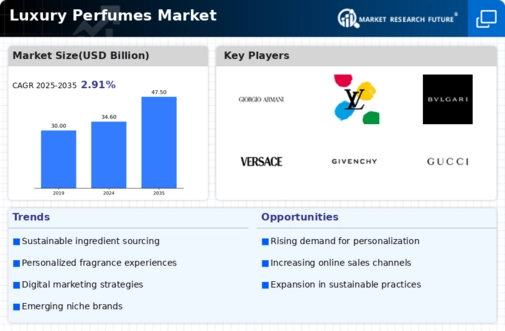Market Growth Projections
Rising Disposable Incomes
The Global Luxury Perfumes Market Industry experiences growth driven by increasing disposable incomes among consumers. As individuals have more financial freedom, they tend to invest in luxury goods, including high-end fragrances. In 2024, the market is valued at 34.6 USD Billion, reflecting a strong consumer preference for premium products. This trend is particularly evident in emerging markets, where a burgeoning middle class seeks to indulge in luxury items. The willingness to spend on luxury perfumes indicates a shift in consumer behavior, suggesting that the market will continue to expand as disposable incomes rise.
Expansion of E-Commerce Channels
The expansion of e-commerce channels significantly influences the Global Luxury Perfumes Market Industry. Online shopping provides consumers with convenient access to a wide range of luxury fragrances, often at competitive prices. This trend is particularly relevant in 2024, as the market is projected to reach 34.6 USD Billion, with e-commerce playing a crucial role in this growth. As more consumers turn to online platforms for their shopping needs, brands that invest in robust e-commerce strategies may capture a larger share of the market. The continued rise of digital retail is likely to shape the future landscape of luxury perfume sales.
Growing Demand for Personalization
Personalization appears to be a key driver in the Global Luxury Perfumes Market Industry. Consumers increasingly seek unique and tailored fragrance experiences, leading brands to innovate in product offerings. This trend is evident in the rise of bespoke perfumes, where customers can create their own scents. Such customization not only enhances customer satisfaction but also fosters brand loyalty. The market's growth is likely to be bolstered by this demand for personalized products, as brands that successfully cater to these preferences may see increased sales and market share.
Sustainability and Eco-Friendly Products
Sustainability is becoming an essential consideration in the Global Luxury Perfumes Market Industry. Consumers are increasingly aware of environmental issues and prefer brands that prioritize eco-friendly practices. This shift has prompted luxury perfume companies to adopt sustainable sourcing, packaging, and production methods. Brands that align with these values may attract a more conscientious consumer base, potentially enhancing their market position. The emphasis on sustainability not only reflects changing consumer preferences but also indicates a broader trend within the luxury sector, which may further drive market growth in the coming years.
Influence of Social Media and Celebrity Endorsements
The impact of social media and celebrity endorsements on the Global Luxury Perfumes Market Industry cannot be overstated. Platforms like Instagram and TikTok serve as powerful marketing tools, allowing brands to reach a wider audience. Influencers and celebrities often promote luxury fragrances, creating aspirational value for consumers. This trend has led to increased visibility and desirability of luxury perfumes, driving sales. As the market evolves, brands that effectively leverage social media strategies may experience significant growth, contributing to the projected market value of 47.5 USD Billion by 2035.






















